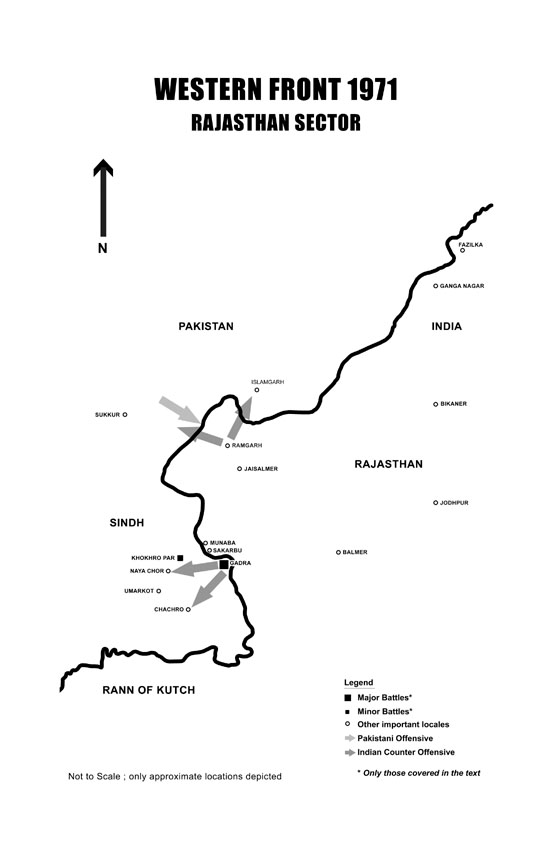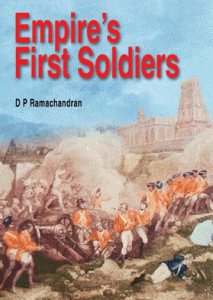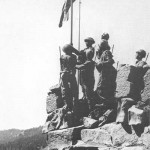 Late in the evening on the 16th the enemy counter-attacked again. The battalion now under the command of Major RP Sharma, Ghai’s Second-in-Command, fought back as resolute as ever to throw the enemy back once again. But the Pakistanis were not done in yet. Early morning on 17 December they came in a big way, preceded by their aircraft strafing the position. The ground attack came at 0700 hours. They gave their best; but it wasn’t good enough against the plucky warriors of the ‘Shining Sixteenth’. Battle-weary, but hardened by more than thirty-six hours of intense combat, they fought like the devils. The attack was brutally rolled back with the enemy finding their enormously mounting casualties no more acceptable.
Late in the evening on the 16th the enemy counter-attacked again. The battalion now under the command of Major RP Sharma, Ghai’s Second-in-Command, fought back as resolute as ever to throw the enemy back once again. But the Pakistanis were not done in yet. Early morning on 17 December they came in a big way, preceded by their aircraft strafing the position. The ground attack came at 0700 hours. They gave their best; but it wasn’t good enough against the plucky warriors of the ‘Shining Sixteenth’. Battle-weary, but hardened by more than thirty-six hours of intense combat, they fought like the devils. The attack was brutally rolled back with the enemy finding their enormously mounting casualties no more acceptable.
The battalion didn’t come through it very lightly either. The new CO’s (Sharma’s) valiant command lasted barely a day – he fell like his predecessor, cut down in action while leading his men to greater glory. The rest of the officers weren’t any less either with their fiery brand of leadership in the battle. The Adjutant, Major V Mahalingam, wounded but refusing to be evacuated and rallying the men against odds, set an inspiring pattern. Second Lieutenant Shivcharan Singh, the Intelligence Officer, young but full of courage, was killed in action. Another officer, Captain JP Singh, could be seen bodily evacuating the casualties himself fully exposed to fire.
The Pakistanis made their last desperate bid to overrun the bridgehead towards sunset on the 17th. Once again, despite the fatigue and mounting casualties, the battalion held on doggedly until the attack was repulsed. The battle died down after that, and the ceasefire was on by the next morning. That day, 18 December, the men of 11 Baluch, the Pakistani unit which had faced the Madras Battalion, carried away their dead from the area. 40 bodies were counted; merely a portion of the many the Pakistanis had had to count at Basantar. Repeated efforts by the bulk of their 8 Independent Armoured Brigade and 124 Infantry Brigade to overrun the Indian bridgehead had come to bear no fruit, and had cost them heavily.
‘The Battle of Basantar’ was over. It was a magnificent battle – the kind of stuff legends are made of. The casualty count of 16 Madras at the end of the war showed, 5 officers and 27 JCOs and Other Ranks killed, and 1 officer and 103 JCOs and Other Ranks wounded; a total of 136 casualties, among them, the unit’s Commanding Officer, Second-in-Command, Adjutant, and three more officers. Lieutenant Colonel VP Ghai was awarded the Maha Vir Chakra posthumously. A second Maha Vir Chakra was awarded to Havildar Thomas Philipose of C Company for exceptional gallantry at Lalial. C Company’s Commander, Major PV Sahadevan, was awarded a Vir Chakra; so was Naik A Sahadevan and the Regimental Medical Officer, Captain Surendranath, the latter two posthumously. The impressive tally of the gallantry awards won by the battalion during the 1971 War included two more Vir Chakras, 2 Sena Medals and 6 Mention-in-Dispatches.
17 Madras, operating off Muktsar under 116 Infantry Brigade of 14 Division (Command Reserve allotted to 11 Corps), captured two enemy outposts, Killi Sahu on 13 December and Churka on 17 December. Brief but sharp engagements, they won the unit five gallantry awards: a Vir Chakra to Naik Vasudevan Bhaskaran for his heroic initiative at Killi Sahu in silencing an enemy machinegun, a Sena Medal to Lieutenant Uday Shankar for his outstandingly courageous leadership in that battle, two more Sena Medals to Naib Subedar Kunhikrishnan and Sepoy Selvarajan Naidu for displaying exceptional bravery at Churka, and a Mention-in-Dispatches to Second Lieutenant Agarwal for his courageous initiative in the same engagement. One officer and three men being wounded were the only casualties the battalion suffered. The unit continued to be deployed on the banks of Sutlej after the ceasefire as part of the defences for a while.
The battalions engaged in Rajasthan were 9, 18 and 27 Madras. 9 Madras, commanded by Lieutenant Colonel DB White, which formed part of 330 Infantry Brigade under 11 Division, began the operations by joining the main offensive of the sector launched on 4 December on the Gadra City-Nayachor Axis. Temporarily placed under 31 Infantry Brigade in the initial phase, it took part in the capture of Gadra City before being assigned to 85 Infantry Brigade, which captured Khokhro Par subsequently. On 6 December the battalion went on to capture Mahendra Ro Par on the Gadra City-Umarkot Axis, before being reverted to 330 Brigade to join the main thrust on Nayachor. The division hit the enemy screen on the 12th. During the night 13/14 December a salient of prime tactical significance, Parbat Ali, was taken. Reconnaissance found Nayachor to be strongly held, and a divisional attack was planned to tackle it. This called for large scale preparations involving construction of vehicular tracks and laying of rail lines to facilitate forward concentration. The offensive was inevitably stalled, and the war ended with the enemy still holding Nayachor.
During the reconnaissance phase, a deep penetration patrol of 9 Madras had gone as far as Khat Singh. The battalion had advanced beyond Point 315, a strongly held enemy position, when the ceasefire came into effect. Captain R Gopakumar was awarded the Vir Chakra for the extraordinary initiative and boldness with which he conducted quite a few dangerous missions. The unit suffered 10 casualties during the operations; 2 killed and 8 wounded.
18 Madras, commanded by Lieutenant Colonel VS Parmar, made the Indian Army’s deepest thrust in the western desert, as part of 31 Infantry Brigade of 11 Division, by advancing 285 kilometres on foot during the operations, and fought a fierce battle at Hingoro Tar in Sind, Pakistan. Initially they were involved in the capture of Gadra where 9 Madras was engaged too. In the exploitation phase of that operation they took a hamlet, Mahadan Ki Dhani, and brushing aside minor resistance moved up to Chachro in Sind, 80 kilometres short of the Pak defences at Umarkot, by 14 December. Ordered to form up in front of Umarkot, the battalion covered the distance in 48 hours without food or water, surviving on emergency rations, to contact the enemy on the afternoon of 16 December. Firming in beyond the village Hingoro Tar they probed forward, a platoon occupying one end of a sand dune held by the enemy. By then the battalion had outdistanced its artillery support, except for a light battery that fetched up by dusk on 16 December with its stock of ammunition almost exhausted.
The enemy, after subjecting the battalion to intense shelling during the night 16-17 December put in an attack on the 17th. Although the initial attack was beaten back, the battalion had to withdraw some distance under a second attack after about three hours of intense fighting, to a position where proper artillery cover was available. Captain SS Walker, the Mortar Officer of the battalion, whose leadership proved pivotal during the defence of Hingoro Tar and was killed in action, was awarded the Maha Vir Chakra posthumously. Two more of the fallen heroes, Subedar AP Sreedharan and Naik Mani, who both showed exceptional gallantry, were awarded the Vir Chakras posthumously. Four others, Major RG Shastry, Naik KM Haneefa, Naik N Sathyam and Sepoy Bhaskaran Nair, were awarded the Sena Medals. The battalion suffered 31 casualties: 1 officer, 1 JCO and 16 Other Ranks killed, and 3 officers, 2 JCOs and 8 Other Ranks wounded.
27 Madras, a battalion raised just six months prior to the operations (1 June 1971), joined action at Asutar in Jaisalmer Sector on 5 December, to reinforce 12 Infantry Division under attack at Longewala. Taking up position at Asutar they blunted the enemy thrust. After the situation stabilized they were moved to Kutch to contain an enemy intrusion. Although it was achieved, the CO of the battalion, Lieutenant Colonel AO Alexander, was killed along with six of his men, and another four men were wounded, when a reconnaissance patrol of theirs was ambushed across the international border.
19 Madras, commanded by Lieutenant Colonel AS Sidhu, the only battalion of the Regiment to be engaged in J&K, was initially deployed to defend the Ramgarh Ditch, but was inducted into Chamb-Jaurian Sector by 11 December. However since the situation in that sector had stabilized once the Pak attempts to cross the Munawar-Tawi had been thwarted, the battalion was moved back to its original location. They were then engaged in aggressive patrolling of the enemy defences in preparation for an offensive. Though the unit operated constantly under heavy artillery shelling and strafing at various locations during the operations, they were not directly engaged in any major battle. Consequently they suffered no casualties. Nevertheless they were winners of two gallantry awards; one Sena Medal to Naik Daniel Jacob for shooting down an enemy aircraft and one Mention-in-Dispatches to Captain TV Kannan for courage under fire while patrolling.
The Madras Regiment won the Battle Honour, BASANTAR RIVER and the Theatre Honours, PUNJAB 1971 and SINDH 1971, for the operations in the Western Theatre during 1971.
Seven regiments of the MEG, 1, 5, 7, 8, 9, 10 and 201, saw action on the Punjab Border; while two regiments, 6 and 14, were engaged in J&K, and one, 12, was engaged in Ladakh. On the Punjab Border, 1 (Lieutenant Colonel DSR Sahni), 8 (Lieutenant Colonel BM Seth) and 10 (Lieutenant Colonel K Kumaran) Engineer Regiments were in defensive role, and the remaining six regiments were part of one or the other offensive.
5 (Lieutenant Colonel OP Grower) and 9 (Lieutenant Colonel BT Pandit) Regiments advanced with 54 Infantry Division in its thrust towards Zafarwal, culminating in the Battle of Basantar, breaching minefields all the way.
The battle of Basantar turned out to be as much a glorious battle for the Madras Sappers, as it did for the Madras Regiment. Their contribution to facilitating the induction of tanks into the battle was immense. Major VR Chowdhary, commanding 405 Field Company of 9 Engineer Regiment, was killed in action during his gallant bid of supervising the breaching operations under intense shelling, while acting as the officer-in-charge of minefield clearance at Chakra across the Basantar. The officer’s sacrifice didn’t go in vain; his Sappers succeeded in breaching the minefields up to 1600 yards in depth with tank trawls – the first time the concept was tried in an operation – that ultimately made it possible for the tanks and anti-tank weapons to be moved across during the battle. He was awarded the Maha Vir Chakra posthumously. One of his JCOs, Naib Subedar Doraiswamy whose initiative in making a bypass for the tanks proved pivotal ( when their passage was blocked by damaged ones), was awarded the Vir Chakra.
The battle of Basantar claimed the life of one more officer of the Madras Sappers. Captain Ravindranath Gupta had volunteered for a reconnaissance of the wide frontage of enemy minefield across the Basantar. His report was to prove of crucial significance when the tanks were inducted. Unfortunately this brave and resolute officer fell to enemy fire while working on improving the crossing on 17 Decmber, the day the battle was finally won. He was posthumously decorated with the Vir Chakra.
7 Engineer Regiment (Lieutenant Colonel VP Yadav) was part of the I Corps offensive in Shakargarh, supporting 72 Infantry Brigade and 2 Independent Armoured Brigade. In a daring bid they breached the minefield at Tugialpur in broad daylight. The advance had come to a halt before the sappers could be provided a bridgehead, due to stiff enemy opposition and confusion about the location of the minefield. Undeterred, the Regiment got on with their job without waiting for the night. The Officer Commanding 61 Field Company, Major VK Bhaskar, set the pattern by walking right across the minefield to study its extent and type, absolutely aware that it was covered by fire and that he was making himself an easy moving target. Not too far from the officer was a bigger and more tempting moving target; a mine digger operated by Lance Naik Thyagarajan of 664 Plant Company. The officer was awarded a Vir Chakra and the NCO a Sena Medal.
201 Engineer Regiment (Lieutenant Colonel JP Thapliyal) with 36 Infantry Division faced its challenge when the division had to cross the river Ravi, a move not planned earlier. The site available to put up a bridge was that of a ferry, and a registered enemy target. A mile-long sandy approach posed more of a problem than the river itself. The Regiment made it to the water line by midnight 8/9 December. The enemy guns pounding the site claimed 1 sapper killed and 5 wounded; but they had erected a 1350-foot bridge-cum-causeway across the river before sunrise. The Division crossed over and advanced 20 miles within the next 36 hours to come up against Shakargarh.
6 Engineer Regiment (Lieutenant Colonel Thapper) supported 26 Infantry Division in its brilliant strike that cut off the Chicken’s Neck Bulge in Jammu held by the enemy, and foiled his move on Akhnur. 14 Engineer Regiment (Lieutenant Colonel MS Kandal) was engaged in keeping the Srinagar and Awantipur airfields in Kashmir operational despite the havoc bombing caused, and the disposal of unexploded bombs.
In Ladakh, 12 Engineer Regiment (Lieutenant Colonel MM Kumar) supported the Ladakh Scouts in their dynamic foray along the Shyok Valley to capture Turtok and Chalunka.
The MEG won the Battle Honour, BASANTAR RIVER, and the Theatre Honours, JAMMU AND KASHMIR 1971 and PUNJAB 1971, for the operations on the Western Front.
Of 16 Cavalry, only one squadron deployed in the Ikhlaspur-Shakargarh area of the Sialkot Sector could see action in 1971. This was the only unit to contact Shakargarh. The personnel of the regiment won 2 Sena Medals and 6 Mention-in-despatches, besides a Commendation Card from the Chief of Army Staff.
Notes
1. The tanks of this celebrated armoured regiment were to play a pivotal role in beating back the enemy counter-attacks as the battle developed during the day. With barely one squadron strength of tanks available – the two troops inducted initially having been reinforced by two more later – to stop the enemy armour which outnumbered them almost ten to one, the Poona Horse men put up such a ferocious fight that they virtually wiped out two of Pakistan’s famed cavalry regiments. Second Lieutenant Arun Khetarpal, a young officer commissioned only a few months earlier, became the Indian Army’s ideal of ultimate courage under fire when he refused to abandon his burning tank when ordered to, with his legendary radio transmission, “My gun is still working sir”. The lad, barely two months past his twenty-first birth day, was killed in action fighting to his last. He became the youngest soldier to be honoured with the nation’s highest gallantry award, the Param Vir Chakra.
Years later, in a touching gesture of outstanding chivalry, Brigadier Kwaja Mohammad Naser of the Pakistan Army, who, as a major during the war, commanded the squadron of 13 Lancers which was pitched against the Poona Horse tanks in the battle, was to praise the Indian youngster’s valour in glowing terms. The Pakistani Brigadier insisted on being the host to Arun’s father, Brigadier ML Khetarpal (an accomplished officer of the Madras Sappers), who was visiting his birth place in Pakistan with his family; so that he could tell the older man all about it, and feel at peace with himself for his role in the death of someone so young and brave, albeit in the line of his duty as a soldier. The gallant Pakistani officer’s note, that accompanied some photographs he sent to his guest later, epitomized the nobility of the universal brotherhood of men in arms; and starkly revealed the tragedy of the fratricidal conflict that goes on between India and Pakistan, wherein good men are made to kill each other in wars which are not of their making. It read:
“To Brigadier ML Khetarpal, father of Shaheed Second Lieutenant Arun Khetarpal, PVC, who stood like an insurmountable rock, between victory and failure of the counter-attack by the ‘SPEARHEADS’ 13 Lancers on 16 December 1971 in the battle of ‘Bara Pind’ as we call it, and battle of ‘Basantar’ as 17 Poona Horse remembers. Brigadier Khwaja Mohammad Naser, 13 Lancers; 02 March 2001, Lahore, Pakistan.” (Source: Internet)





